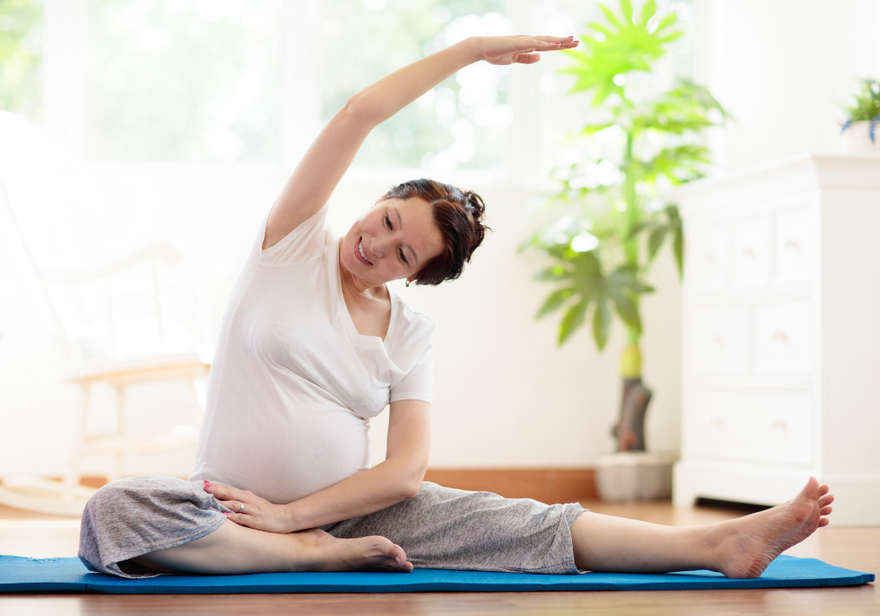How to Exercise During Pregnancy

Pregnancy is a remarkable journey, a time when a woman's body undergoes incredible transformations to nurture the creation of new life. As an expectant mother, taking care of your well-being becomes paramount, not just for yourself but for the precious life growing within you. While a balanced diet, regular prenatal check-ups, and ample rest are essential components of a healthy pregnancy, another often overlooked aspect is exercise.
Let's delve into the importance of exercising during pregnancy and explore the myriad of ways it can positively impact both you and your baby.
Before you Start Exercising
Before starting your fitness routine during pregnancy, it's imperative to prioritise your health and safety by consulting your healthcare provider. Each pregnancy is unique, and factors such as your medical history, current health status, and any potential complications must be taken into account before beginning an exercise regimen. Your healthcare provider can offer personalised guidance tailored to your specific needs, ensuring that you choose exercises that align with your pregnancy journey. This step is vital to minimise any risks and to make informed decisions that will promote both your well-being and your baby's development.
Moreover, as you engage in pregnancy exercises, it's crucial to be attuned to your body's signals and understand when to pause or modify your routine. While exercise can be incredibly beneficial, it's equally important to recognise your limitations and avoid pushing yourself beyond a comfortable threshold. Certain exercises that were well-suited to your pre-pregnancy fitness level might need to be adjusted as your body undergoes changes. Pay close attention to any signs of discomfort, dizziness, shortness of breath, or pain while exercising. If you experience any of these symptoms, stop immediately and consult your healthcare provider. Remember, the goal of exercising during pregnancy is to support your well-being, so always prioritise safety and listen to your body's cues.
What are the Safe Exercises for Pregnant Women?
Safe exercises for pregnant women focus on low-impact activities that support overall fitness, flexibility, and strength while minimising the risk of injury. Hence, pre-appointed consultations for any pregnancy workout routine are key. Here are some safe exercises to do while pregnant.
- Walking: Walking is a gentle and effective cardiovascular exercise during pregnancy. It helps improve circulation, boosts mood, and maintains overall fitness. Aim for a brisk walk for around 30 minutes most days of the week.
- Swimming: Swimming and water aerobics provide low-impact, full-body workouts that ease pressure on joints. The water's buoyancy supports your growing belly, making it a comfortable and refreshing exercise option.
- Prenatal Yoga: Prenatal yoga promotes flexibility, relaxation, and strength. Focus on gentle poses that avoid overstretching or putting too much pressure on your abdomen. Poses like the Cat-Cow, Child's Pose, and Modified Downward Dog can be beneficial.
- Prenatal Pilates: Prenatal Pilates focuses on strengthening your core and improving posture. Opt for classes specifically designed for pregnant women, as they incorporate modifications to ensure safety.
- Stationary Cycling: Cycling on a stationary bike is a low-impact way to engage your leg muscles and improve cardiovascular fitness. Adjust the bike seat and handlebars to accommodate your changing body.
- Low-Impact Aerobics: Participate in low-impact aerobics classes tailored for pregnant women. These classes typically include gentle choreography to maintain your cardiovascular health without straining your joints.
- Pelvic Floor Exercises (Kegels): Strengthening your pelvic floor muscles can help with bladder control and support during pregnancy and childbirth. To perform Kegels, contract and relax your pelvic muscles as if you're stopping the flow of urine.
- Modified Planks: Planks can help maintain core strength. However, perform modified planks by supporting your upper body on your knees instead of your toes, and ensure your back is aligned.
- Stretching: Incorporate gentle stretching exercises to alleviate tension and maintain flexibility. Avoid deep stretches and focus on controlled movements.
- Breathing Exercises: Deep breathing and relaxation techniques can reduce stress and improve oxygen flow during these pregnancy exercises. Practice mindful breathing to stay calm and centered.

Tips to Exercising Safely
Your journey through pregnancy deserves a balance of care and mindfulness. Incorporating exercise into your routine during this special time can bring numerous benefits, but it's essential to approach it with caution and consideration. Here are some insightful tips to guide you safely through exercise during pregnancy, while expecting:
- Warm-Up: Always begin with a gentle warm-up to increase blood flow and prepare your muscles for exercise. Five to ten minutes of light cardio, such as brisk walking, can be effective.
- Stay Hydrated: Ensure you hydrate adequately by drinking water before, during, and after your exercise session. Proper hydration means a happy baby.
- Use Proper Form and Posture: Maintain proper alignment and form to prevent strain on your muscles and joints. Focus on your body's positioning and engage the right muscles.
- Cool-Down: End your workout with a cool-down period that includes gentle stretches to gradually lower your heart rate.
- Stay Balanced: Incorporate a variety of exercises that target different muscle groups to promote overall fitness and prevent overuse injuries.
Exercises to Avoid During Pregnancy
During pregnancy, there are certain exercises and activities that are best to avoid to ensure the safety and well-being of both you and your baby. Exercises that are hazardous for pregnancy include:
- High-Impact Activities: Exercises that involve jumping, bouncing, or sudden changes in direction can strain your joints and increase the risk of injury. Avoid activities like high-impact aerobics and intense running.
- Contact Sports: Activities that involve a high risk of falling, collisions, or impact, such as soccer, basketball, and martial arts, should be avoided due to the potential for abdominal trauma.
- Exercises on Your Back: After the first trimester, avoid exercises that require lying flat on your back for extended periods. This position can put pressure on your vena cava, reducing blood flow to your heart and uterus.
- Deep Abdominal Exercises: Exercises that involve deep twisting or straining of the abdominal muscles, such as full sit-ups, can strain your abdominal muscles and increase intra-abdominal pressure.
- Unstable Surfaces: Avoid exercises on unstable surfaces like balance balls or wobble boards, as your balance and stability are compromised during pregnancy.
- Breath-Holding Activities: Activities that involve holding your breath for extended periods, such as certain yoga poses or free diving, can reduce the oxygen supply to your baby.
- Overstretching: Avoid deep stretches that could strain your ligaments, especially the hormone relaxin, which is produced during pregnancy to make joints more flexible and susceptible to injury.

Warning Signs & Precautions
While exercise can offer numerous benefits during this special time, it's essential to be aware of warning signs and take necessary precautions to ensure both your safety and your baby's well-being. When you detect these negative symptoms, it is important to seek help immediately.
- Vaginal Bleeding: Any vaginal bleeding during pregnancy is a serious concern. Stop exercising immediately and consult your healthcare provider.
- Dizziness or Fainting: If you feel dizzy, lightheaded, or experience fainting spells while exercising, stop and rest. It could indicate a drop in blood pressure.
- Shortness of Breath: It's normal to experience mild shortness of breath during exercise. If it becomes severe or you struggle to catch your breath, slow down or stop.
- Severe Fatigue: Feeling overly exhausted during or after exercise may be a sign that you're overexerting yourself. Rest and hydrate if needed.
- Chest Pain or Palpitations: Any chest pain, irregular heartbeat, or palpitations should be taken seriously. Cease exercise and seek medical attention.
- Muscle Weakness or Contractions: If you experience sudden muscle weakness, severe abdominal pain, or uterine contractions during exercise, stop immediately and consult your healthcare provider.
- Amniotic Fluid Leakage: If you suspect your amniotic fluid is leaking (feeling a sudden gush of fluid or experiencing a continuous trickle), halt exercise and contact your doctor.
- Headache: Intense headaches during exercise could be a sign of elevated blood pressure or other health concerns. Stop exercising and consult your healthcare provider.
Incorporating safe and mindful exercise into your pregnancy journey can be an empowering way to nurture both your body and spirit. By staying attuned to your body's signals, consulting your healthcare provider, and adhering to the recommended precautions, you're setting the stage for a healthier and more enjoyable pregnancy experience.
As you engage in exercises that support your well-being and adapt to your changing needs, remember that the goal isn't just to stay fit, but to create a positive and harmonious environment for you and your growing baby.









